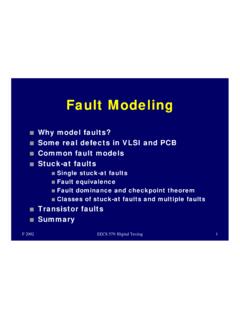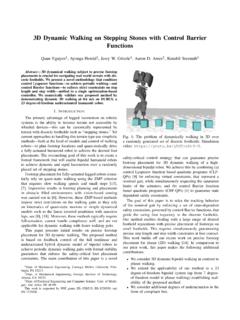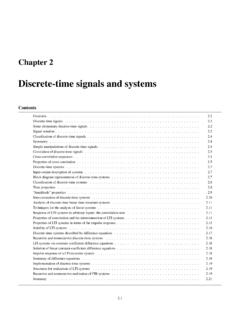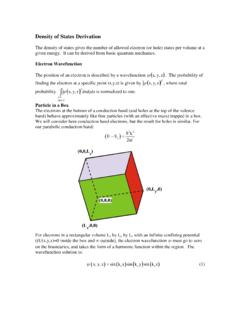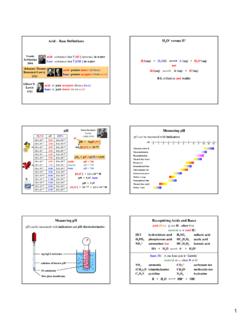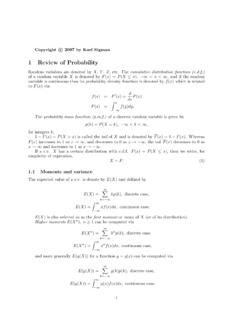Transcription of 1 Z-Transforms, Their Inverses Transfer or System Functions
1 1Z-Transforms, Their InversesTransfer or System FunctionsProfessor Andrew E. Yagle, EECS 206 Instructor, Fall 2005 Dept. of EECS, The University of Michigan, Ann Arbor, MI 48109-2122I. AbstractThe purpose of this document is to introduce EECS 206 students to the z- transform and what it s for. Italso introduces Transfer ( System ) Functions and shows how to use them to relate System Table of contents by sections:1. Abstract (you re reading this now)2. Forward Z-Transforms: How do I compute z-transforms?3. inverse Z-Transforms: How do I undo a z- transform ?4. Transfer ( System ) Functions : What are they for?5. Poles and Zeros: Transient and Frequency Responses6. The Atlanta Airport: (Has he completely lost his mind?)7. Half-Dozen Examples: This stuff is actually very useful!Why should you care about z-transforms and Transfer Functions ? Because of problems like this:Giventhat the response of an LTI System to input (12)nu[n] is output{0,0,1}= [n 2],Computethe response of the System to input 2 cos( 3n).
2 That is:Ifx[n] = (12)nu[n] LTI y[n] ={0,0,1}, thenx[n] = 2 cos( 3n) LTI y[n] =?By the end of this document, we will solve this very problem, and quite easily. How? Read Forward Z-TransformsWe consider the cases of finite-duration and infinite-duration signals Finite-Duration SignalsLetx[n] be a discrete-time signal which is: Causal (x[n] = 0 forn <0) Finite Duration (x[n] = 0 foralln > Nfor someN)2 Thez-transformofx[n] is the polynomial (inz 1)Z{x[n]}=X(z) =x[0] +x[1]z 1+x[2]z 2+..+x[N]z N= (x[0]zN+x[1]zN 1+..+x[N])/zN(1)Why do z-transforms usez 1instead ofz? It s always something Gilda Radner onSaturday Night there is a good reason for this see below under Poles andZeros. Three important properties of the z- transform that follow from its definition: Linearity:Z{ax[n] +by[n]}=aX(z) +bY(z) whereX(z) =Z{x[n]}andY(z) =Z{y[n]} Use this to break up computation of z- transform (and Their Inverses ) Delays:Z{x[n D]}=z DZ{x[n]}=z DX(z) Delaying a signal byD >0 multiplies its z- transform byz D But remember that the z- transform is only defined for causal signals Convolution:Z{x[n] y[n]}=X(z)Y(z) whereX(z) =Z{x[n]}andY(z) =Z{y[n]} This follows since convolution is polynomial multiplication Just think no more convolutions to compute!
3 You should likeZalreadyTwo examples that pretty much tell the whole story for finite-duration signals:Z{3,1,4,2,5}= 3 + 1z 1+ 4z 2+ 2z 3+ 5z 4= 3z4+ 1z3+ 4z2+ 2z+ 5)/z5Z{2 [n] + 7 [n 2] + 3 [n 5]}= 2 + 7z 2+ 3z 5= (2z5+ 7z3+ 3)/z5(2)Recall that the underline in the first example shows the location of timen= 0. The second example can beperformed either directly from the definition, or by using the linearity and delay properties onZ{ [n]}= Infinite-Duration SignalsNow letx[n] be a causal signal of infinite duration ( ,x[n] can be nonzero for arbitrarily large timen).The z- transform ofx[n] is now the power seriesZ{x[n]}=X(z) =x[0] +x[1]z 1+x[2]z 2+..= n=0x[n]z n(3)If you know what a Laplace transform is, this should look likea discrete-time version of it, as indeed it you don t know what a Laplace transform is, you aren t missing anything that will help above three properties still hold, but computingX(z) now requires use of:1 +r+r2+r3+..= 1/(1 r)IF|r|<1(4)3 You will use this equation extensively in this document!
4 Starting right now:Z{anu[n]}= 1 +az 1+a2z 2+..= n=0anz n= n=0(a/z)n=11 az 1=zz a(5)This formula is only true for|a/z|<1 |z|> a. This is called theregion of convergence(ROC) of thez- transform . In EECS 206 this is fine print that you can ignore. In EECS 451 things will beverydifferent!Recallu[n] is the unit step function:u[n] = 1 forn 0 andu[n] = 0 forn <0. Multiplication byu[n]simply takes the causal part ofan. In fact, note thatZ{u[n]}=11 z 1=zz 1(6)C. Examples of Infinite-Duration SignalsA simple example, just plugging into this formula:Z{3nu[n]}=11 3z 1=zz 3(7)A more interesting example that uses linearity and delay properties and illustrates an important point:Z{u[n] u[n 2]}=zz 1zz z 2zz 1=z2 1z(z 1)=z+ 1z= 1 +z 1(8)But that looks like the z- transform of{1,1}! Did we make a mistake? No, becauseu[n] u[n 2] ={1,1}= [n] + [n 1](9)This is one of many things about EECS 206 that can drive you crazy getting the right answer and notknowing it. This happens because there is more than one way ofrepresenting a signal.
5 While this flexibilityis very useful, it can be aggravating. Try plotting your result using Matlab to see if it matches the correct answer, which may just be your answer in a different complex (snicker) example, using linearity:Z{cos( n)u[n]}=Z{12[ej n+e j n]u[n]}=12Z{ej nu[n]}+12Z{e j nu[n]}=12zz ej +12zz e j (10)This is algebraically correct, but we can put the two terms over a common denominator:X(z) =12zz ej z e j z e j +12zz e j z ej z ej =122z2 ze j zej z2 ze j zej + 1=z2 zcos( )z2 2zcos( ) + 1(11)4An example of plugging into this formula:Z{cos(( /3)n)u[n]}=z2 zcos( /3)z2 2zcos( /3) + 1=z2 z+ 1(12)since cos( /3) = (1/2). Note the ROC is|z|>|ej |= 1 for any .D. Finite-Duration-Plus-Infinite DurationThe significance of linearity of the z- transform is shown in these two examples:Z{{3,1,4}+u[n]}=3z2+ 1z+ 4z2z 1z 1+zz 1z2z2=4z3 2z2+ 3z 4z3 z2(13)Simple enough, but try this:Z{2 cos(( /3)n)u[n] {2,1}}= 2Z{cos(( /3)n)u[n]} Z{2,1}=2z2 zz2 z+ 1 (2 +z 1)(14)Again, this is algebraically correct, but we can put both terms over a common denominator:X(z) =2z2 zz2 z+ 1 2z+ 1z=2z2 zz2 z+ 1zz 2z+ 1zz2 z+ 1z2 z+ 1= z+ 1z3 z2+z(15)Note that the degree of the numerator is less than the degree of the denominator.
6 This is called astrictlyproperfunction, and it tell us thatx[0] = 0. Why? For any causal functionx[n], we havelimz X(z) = limz (x[0] +x[1]z 1+x[2]x 2+..) =x[0](16)This is called theInitial Value Theoremfor the z- transform . It tells us: If degree[numerator]<degree[denominator] (strictly properX(z)), thenx[0] = 0 If degree[numerator]=degree[denominator] (properX(z)), thenx[0]6= 0 If degree[numerator]>degree[denominator] (improperX(z)), thenX(z) is wrong!The aboveX(z) has degree[numerator]=degree[denominator]-2. This impliesx[0] =x[1] = 0. Indeed,note thatx[n] was constructed so that this would be the this obsession with writingX(z) as the ratio of two polynomials? You ll find out in the next is called arational function, just as the ratio of two integers is called a rational Application of Z-TransformAlready we can use z-transforms to make our life easier. Consider the following problem:Given:An LTI System is described by thedifference equationy[n] 2y[n 1] =x[n 1] x[n 2].
7 Goal:Compute the outputy[n] if the inputx[n] = 3nu[n]. That is,x[n] = 3nu[n] y[n]-2y[n-1]=x[n-1]-x[n-2] y[n] =?(17)5 Solution:Take the z-transforms of the difference equation and of the input. This yieldsY(z) 2z 1Y(z) =z 1X(z) z 2X(z);X(z) =zz 3(18)Inserting the second equation into the first givesY(z) =z 1 z 21 2z 1zz 3=z 1(z 2)(z 3)=2z 3 1z 2(19)and just looking at the last expression, we recognize thaty[n] = 2(3)n 1u[n 1] (2)n 1u[n 1] =FORCEDRESPONSE(likex[n])+NATURALRESPONS E(likeh[n])(20)Note thaty[n] has a term that looks like the input (forced response) and a term that looks like the impulseresponse (natural response). This almost always did I get that last expression from the next-to-last one?Read inverse Z-TransformsAs long asx[n] is constrained to be causal (x[n] = 0 forn <0), then the z- transform is invertible: Thereis only onex[n] having a given z-transformX(z). Inversion of the z- transform (gettingx[n] back fromX(z))is accomplished by recognition: Whatx[n] would produce thatX(z)?
8 Linearity of the z- transform allowsus to break upX(z) into parts, each of which can be inverted separately. But usually we will have to usepartial fractionsto accomplish this (see below).A. Inversion by RecognitionSometimes z- transform inversion is easy:Z 1{2z4+ 7z3+z2+ 8z+ 3)/z4}=Z 1{2 + 7z 1+z 2+ 8z 3+ 3z 4}={2,7,1,8,3}(21)As before, this can be performed either directly from the definition, or by using the linearity and delayproperties onZ 1{1}= [n]. An example with different types of terms to recognize:Z 1{4z+ 5z2+61 3z 1}=Z 1{4z 1+ 5z 2}+ 6Z 1{11 3z 1}={0,4,5}+ 6(3)nu[n](22)Don t forget the step functionsu[n] your inverse z- transform must be zero forn <0. Otherwise it s wronghalf the time, and you should only get half credit for it on an exam!Z 1{7zz 1+8zz 2}= 7Z 1{zz 1}+ 8Z 1{zz 2}= 7u[n] + 8(2)nu[n](23)6 This works if yourX(z) happens to be written as a sum of terms of the formsbzz a: Each term becomesbanu[n]. How do we make that happen? This should look familiar perform apartial fraction expansionofX(z).
9 But there s a twist involved see Review of Partial Fraction ExpansionsAnyrational functionX(z) that isstrictly proper(both terms defined above) can be expanded asX(z) =(z z1)..(z zM)(z p1)..(z pN)=A1z p1+A2z p2+..+ANz pN(24) Strictly proper here meansN > Min the rational functionX(z). Thepoles{pn}are the roots of the denominator polynomial=0. Thepoles{pn}are assumed to be distinct (no two are equal); Repeated roots of polynomials don t occur in real life unless forced to. IfX(z) is real, both poles and residues occur in complex conjugatepairs: IfAnis the residue forpn, thenA nis the residue forp n. Theresidues{An}are computed using the following formula:An=X(z)(z pn)|z=pn=(pn z1)..(pn zn)..(pn zM)(pn p1)..(pn pn 1)(pn pn+1)..(pn pN)(25)A simple example: Compute the partial fraction expansion ofz 3z2 3z+ Compute thepoles:z2 3z+ 2 = (z 1)(z 2) = 0 p1= 1 andp2= 22. Compute theresidues:A1=1 31 2= 2 andA2=2 32 1= 13. Plug in:z 3z2 3z+2=2z 1 1z 2(confirm by cross-multiplying)A complex (snicker) example: Compute the partial fraction expansion of2z2+ Compute thepoles:z2+ 1 = (z j)(z+j) = 0 p1=jandp2= j2.
10 Compute theresidues:A1=2j+j= jandA2=2 j j=j3. Plug in:2z2+1=jz+j jz j(confirm by cross-multiplying)4. Notep2=p 1andA2=A 1(conjugate pairs)The existence of the partial fraction expansion will not be derived here. The formula for the residues followsimmediately by multiplying both sides of the expansion by (z pn),performing the cancellation inX(z)andinAnz pn, and settingz=pn. Then all terms are wiped out exceptX(z)(z pn)|z=pn= (z) is only proper ( , the numerator and denominator polynomials have the same degree), and notstrictly proper, then the partial fraction expansion has a constant added to it. IfX(z) is improper, it has apolynomial added to its partial fraction expansion. This polynomial can be computed most easily by dividingthe denominator into the numerator, but polynomial division is almost a lost art. We won t use these computes the above partial fraction expansion using[R,P,K]=residue([1 -3],[1 -3 2]);whichgivesR=[-1 2] andP=[2 1] , so that Residues -1 and 2 are associated with Poles 2 and 1, is no constantKsincez 3z2 3z+2is strictly Inversion Using Partial FractionsThe following six-step procedure computes the inverse z- transform of a proper rational functionX(z):1.





